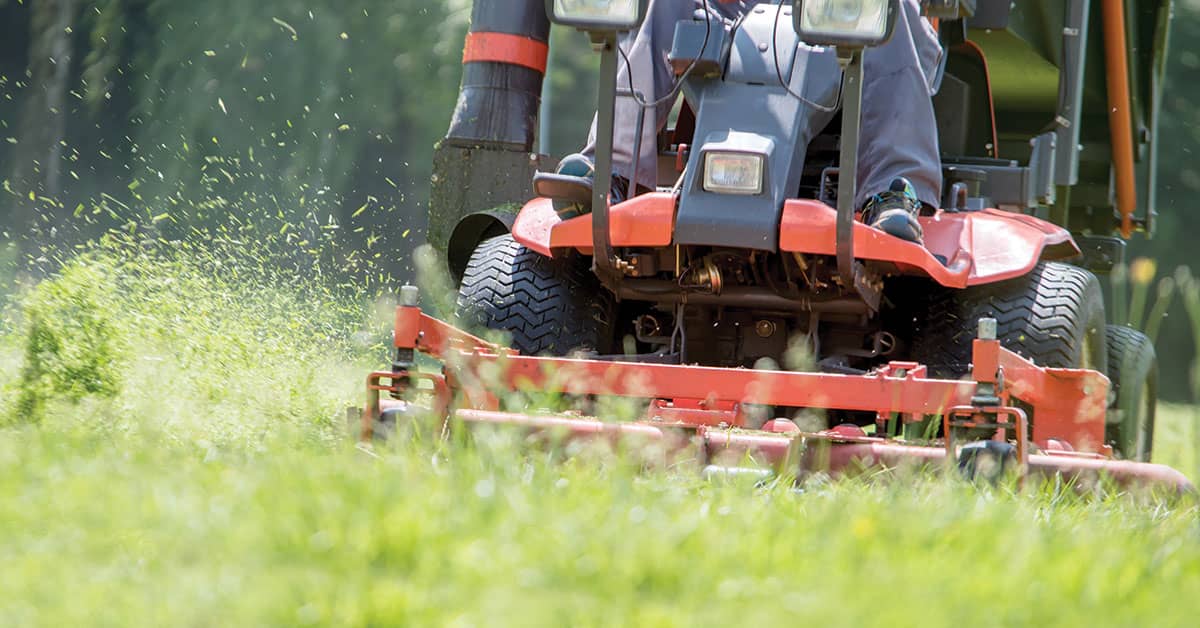Lawncare season is here. Are your employees prepared?
Date Posted: 04/29/2024

A 36-year-old lawn mower operator was riding a zero-turn lawnmower in a residential neighborhood when it tipped over into a water retention pond, pinning and subsequently drowning the worker. OSHA investigators learned the machine’s roll-over protection system (ROPS) was not engaged while operating on a sloping embankment near the pond and the equipment was operated on a slope that exceeded the limitations defined in the equipment manual.
Landscaping is one of the highest risk industries in the service industry. A Bureau of Labor Statistics report shows 1,242 work-related fatalities occurred in the landscaping and groundskeeping industry from 2011-2022. Operating machines near water hazards, such as ponds and ditches, represents a known occupational hazard to landscape workers.
What are the hazards?
Landscaping workers are at risk of injury from a variety of potential hazards, including exposure to chemicals, noise, machinery, lifting, repetitive motions, construction activities, and weather-related hazards. While there’s no OSHA regulation specific to the industry, landscaping and horticulture hazards are addressed in the general industry standards (29 CFR 1910) if work is considered maintenance activity and in the construction standards (29 CFR 1926) if work is considered building activity.
A look at the top violations in NAICS code 561730, Landscaping Services, shows where employers may want to focus their safety and health efforts:
- 1910.132 – Personal protective equipment (PPE) – general. Employers must conduct a hazard assessment, select appropriate PPE for employee use, and train employees.
- 1910.1200 – Hazard Communication. Employees exposed to hazardous chemicals must be trained, among other requirements.
- Section 5(a) of OSH Act - General Duty Clause. This may include heat/cold exposure and ergonomics.
- 1926.1153 – Respirable crystalline silica. This regulation applies to occupational exposures to respirable crystalline silica in construction work and includes provisions for protection and training.
- 1910.135 – Head protection. Employees must wear a protective helmet when working in areas where there’s a potential for injury from falling objects and when working near exposed electrical conductors.
- 1910.28 – Duty to have fall protection and falling object protection. Employers must provide protection and training for each employee exposed to fall and falling object hazards.
- 1910.67 – Vehicle-mounted elevating and rotating work platforms. Employees must be trained to use powered platforms, manlifts, and vehicle-mounted work platforms.
- 1910.133 – Eye and face protection. Employees must use appropriate PPE when exposed to hazards from flying particles, molten metal, liquid chemicals, acids or caustic liquids, chemical gases or vapors, or potentially injurious light radiation.
- 1910.333 – Electrical - selection and use of work practices. Safety-related work practices must be employed to prevent electric shock or other injuries resulting from either direct or indirect electrical contacts, when work is performed near or on equipment or circuits which are or may be energized.
- 1910.30 – Walking-working surfaces – training requirements. Training must be provided to employees who use personal fall protection systems and equipment such as ladders, ladder safety systems, portable guardrails, designated areas, scaffolds, safety net systems, and rope descent systems.
While regulatory requirements play a large role in employee training, it’s of note that equipment manuals – as noted in the fatal incident above – provide guidelines for safe operation and use. Employees should be trained accordingly. Some manufacturers or distributors offer training on the equipment they sell.
How Safety Management Suite Can Help
Training helps ensure employees have the information and skills they need to keep themselves safe on the job. The Training area of the J. J. Keller® SAFETY MANAGEMENT SUITE provides numerous resources that you can modify to meet your needs, including handouts that employees can take and reference later.
E-mail Newsletter
Sign up to receive the weekly EHS Insider email newsletter for safety articles, news headlines, regulatory alerts, industry events, webcasts, and more.